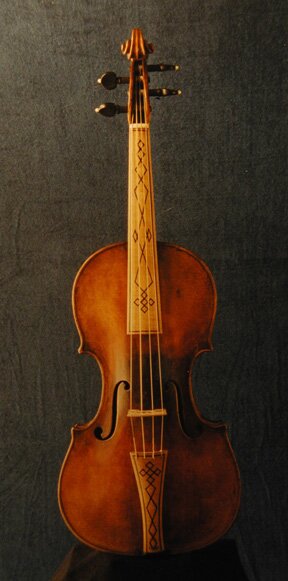A Case in Point
A Violin: Who made this instrument?
(A warning about attributions by knowledgeable experts on violins)

This is a beautiful violin: there is no doubt about that! But who made it?
My curiosity was aroused by a comment from one of the internationally recognized experts from London: “This violin must be a very early Stradivarius, from the 1660’s, when he was working under the tutelage of Amati, or perhaps a Nicolò Amati!” Now, when an acknowledged expert utters such words, one is obliged to take him seriously. I did. In my efforts to establish beyond a doubt the true origin of this violin I took it to internationally reputed experts in the following cities (no names, please!), often consulting more than one expert in each city:
Vienna, Basel, Hamburg, Paris, London, New York, Chicago, Den Haag, Amsterdam, Brussels and others.
Here are the comments made by the enlightened ones as to the origin of this violin:
1. An early Stradivarius, from the 1660’s or a Nicolò Amati
2. A German violin of the 19th C. of no particular note
3. A particularly fine example by one of the makers of the Kloz Family, Mittenwald, ca. 1760
4. An excellent copy of an Amati violin, made in England, ca. 1700
5. A fine old dutch violin
6. A violin from North France or Flanders
Interesting, isn’t it?
The fact is that about 3000 names of violin makers are known to us, from the origins of the trade in the 16th C. to the 20th C. But, curiously, all the certificates currently in circulation attribute existing musical instruments to only around 300 of those violin makers. This would imply that 2700 makers actually spent their time observing with great interest what those 300 luthiers were doing, but did not in fact build any instruments themselves… I know that this might be a bit difficult to swallow, but that’s the way it is with certificates!
The attributions found on this web site (as well as those found elsewhere) should therefore be taken cum grano salis.
The names given to instruments of the Orpheon Foundation have been proposed when at least one expert has consided this particular instrument to be by that maker. Others may – and most likely will – disagree!
One of the most important tools in the identification of the age of a particular instrument is dendrochronology. This relatively recently developed scientific method can establish beyond a reasonable doubt when the tree was felled from which the instrument was made. It cannot tell us who made the instrument in question, but it can tell us more or less when it was made and possibly provide some clues as to the general region of origin. In the near future, several of the more salient instruments of óur collection will be submitted to dendrochronological scrutiny. We are all looking forward to the results!
What is this violin?
The answer, to the best of my knowledge: